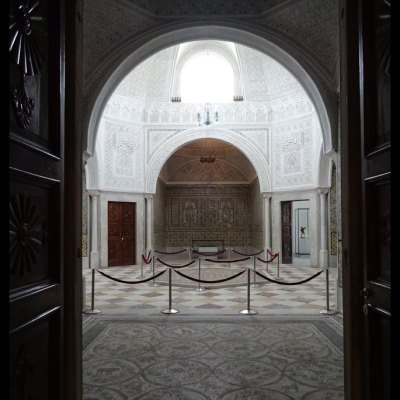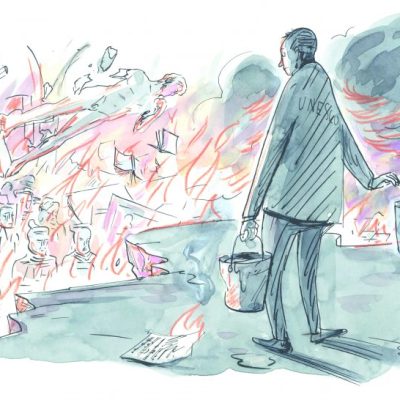Earlier this year, 114 historical artefacts from Tunisia were offered for sale at an auction house in Paris. The collection, including manuscripts, medals, cloaks, correspondence and glass, in Coutau-Bégarie’s Nobility & Royalty sale at the Hôtel Drouot, had been assembled by the Djellouli family, dignitaries-cum-merchants who rose to prominence in the 18th century. The items were offered by a member of the Djellouli family whose identity is being kept private; but before the auction could take place on 11 June, the Tunisian government asked for their return. Their sale was subsequently suspended.
On the week the sale had come to light in the Tunisian media, I happened to meet Belhassan Djellouli, another family member – but not the seller – in a private library in Tunis. He told me that a (female) journalist had called him to ask why the family was selling off the heirlooms. ‘I told her,’ he said. ‘“Back in the day, it was women that our family bought and sold. If you came to our house, we might have bought and sold you,”’ he said as he sat below a photo of his uncle, Ahmed Djellouli, on the wall.
The politician Habib Djellouli, photographed before 1957. Wikimedia commons
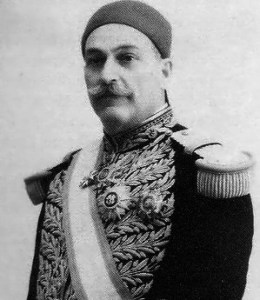
It was Ahmed Djellouli who had owned the items in question until his death in 2011. He was one of the few remaining beldi – aristocratic Tunisois – who still resided in the medina, the old part of Tunis, and his collection was made up of objects inherited from his father, Habib (1879–1957), who occupied various ministerial positions during the French colonial period, as well as some of his own acquisitions. His address – on the Rue du Riche, named as such after Mahmoud Djellouli bought a house there in the 18th century – was known to researchers and visitors to the medina; he would spend time reading books and manuscripts at the National Library and was often contacted by the National Heritage Institute (INP) to speak at events or to loan objects for exhibitions, remembers Faouzi Mahfoudh, director of the INP: ‘He was someone respected and respectable; he was trusted by the successive directors of the INP, Allah yarhamu.’
Tunisian law stipulates that privately owned objects that are of national importance cannot be exported abroad without the authorisation of the ministry of culture. But objects from private collections belonging to the beldiya are exported all the time, says Yasser Jrad, head of the seized objects department at the INP. ‘There are bigger and more valuable collections that have been sold abroad but there was no noise because it didn’t spread on social media,’ he says. Recalling Tunisian objects from an auction abroad is ‘nearly impossible’, Jrad explains, because without an inventory of the family collection, it is difficult to prove the items were in Tunisia. It is so rare that, in a speech before UNESCO’s executive committee, the organisation’s director-general Audrey Azoulay cited this case as an exemplar of successful protection of heritage in the international market. Ghazi Gherairi, Tunisian ambassador to UNESCO in Paris, who was in charge of recovering the objects, was able to enter into dialogue with the auction house and the Conseil des Ventes Voluntaires that oversees the French art market and to suspend the sale after the ministry of culture and INP declared the objects to be national heritage. This set in motion the 1970 convention on illicit import, export and transfer of ownership of cultural property, to which both France and Tunisia are signatories. But this recovery, Gherairi says, was only possible due to a combination of ‘the cooperation of one part of the [Djellouli] family, the intervention of the [Tunisian] authorities and the interest from public opinion, which is something new – the public is vigilant’.
Raja Ben Slama, director of the National Library, is resigned to the fact that the country advances thanks to ‘scandals’ like the Djellouli artefacts, which she hopes will also raise awareness of the existing laws. ‘Before the [2011] revolution, this application of the law wouldn’t have been possible – the bending of rules and clientelism was more important than heritage,’ she says. I put this to the historian Salhi Sghaier, author of Internal Colonialism and Unequal Development, in which he analyses the endurance of powerful families from the time of the bey. He is more pessimistic and says the Djelloulis just lost out in the reshuffling of what he refers to as the modern-day Makhzen (governing elite). ‘If this was still a powerful family, this wouldn’t have happened. This is just a sign that this family is in decline.’
The Djelloulis were one of the most powerful families during the time of the beys, monarchs that ruled Tunisia as an autonomous province of the Ottoman empire. The family was part of the caste appointed by the bey to dominate the country’s affairs and rule over the people. They armed corsairs and collected taxes, while often having the privilege of not paying any themselves. ‘They were merchants, they bought and sold everything, everything that one could buy – soap, slaves, olives, leather, wool, hemp,’ says Moadh Djellouli, 77, another member of the family, on a visit to the ancestral home in the Tunis medina. As for politics, there was almost never a time when one or two Djelloulis did not hold the position of caid, a regional governor appointed by the bey, or serve as a minister in the court; two Djelloulis were prime ministers after the establishment of French colonial rule in 1881. The French insisted on having a Djellouli, Aziz, as part of the 1954 ‘negotiation government’ for independence. Moadh says he didn’t know anything about the sale in Paris. ‘Each person has a key and they can do what they want,’ he says. ‘These are family belongings, so we need to have a meeting as a family… but for that we need to go back to the Greek era.’
In the Coutau-Bégarie catalogue, one of the manuscripts – a late 18th/early 19th-century Qur’an, with gold and floral illuminated texts and a handwritten dedication from 1942 to Moncef Bey, who later gave the book to a Djellouli – was estimated at €3,000–€3,500. A medal on a silk ribbon from the time of Ali Bey belonging to Habib Djellouli had a guide price of €3,000–€5,000. London-based Islamic art dealer Irene Momtaz says, ‘Collectors have different opinions, but the pieces are not in the best condition and the calligraphy is not the highest standard artistically, the glass is purely decorative,’ she says. It may be a historical document, but ‘if it is not a work of art, it doesn’t have much [monetary] value’. Belhassan Djellouli, too, says of the collection, ‘It is nothing’ and so its sale should not be considered illegal. As for the relative who offered the items, he adds, ‘It wasn’t to enrich himself – he did it to share the history of the family, to give value to the family name.’
Among 114 objects that were up for auction, 105 are to be confiscated upon their arrival back in Tunisia ‘for safekeeping’ due to their national importance. The remaining manuscripts have been seized from the family house as a preventative measure, according to Ben Slama of the National Library, which had tried to acquire some of the manuscripts earlier this year. ‘I don’t want to dispossess people of their belongings. I just want to apply the law,’ she says, not without pleasure. The library had proposed to buy three items – two 19th-century manuscripts of religious poems and the biography of a modern Tunisian writer – at 2,200 Tunisian dinars (€614), and intended to buy more later. ‘We have a huge budget problem – we even have problems paying for the light and the air conditioning – so we said we would buy their collection bit by bit,’ says Rachida Smine, the library’s head of manuscripts, who carried out the inventory. ‘It’s just a few poems. It’s not like we were buying the Canon of Avicenna. That is their worth, but the dinar is weak now: 500 would have been 500 euros before.’ The proposal was refused.
The Rue du Riche in the the medina, Tunis. Photo: the author
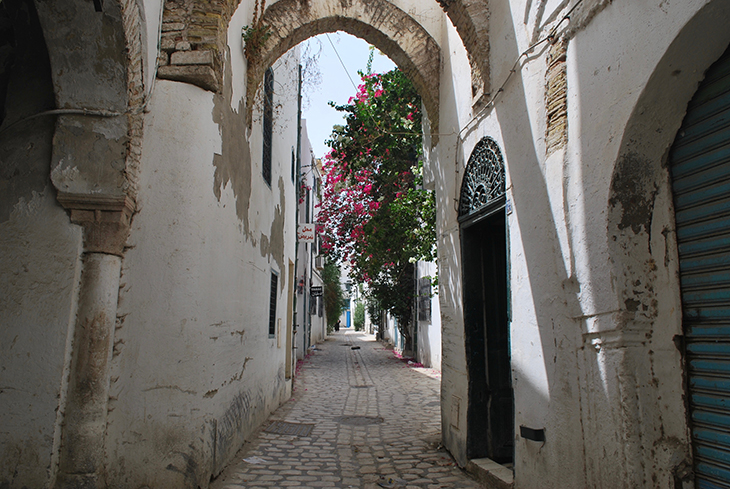
After the death of Ahmed Djellouli, the grand yellow doors to the old family home closed – except to those who make a reservation on booking.com for the top floor, which has been turned into a guesthouse by Belhassan after his retirement from the hotel industry. The manuscripts were locked up; some grew mouldy (I am told by someone who has seen them) and some were sold. Annexed to the house is a tourbet, a private mausoleum for family members, but no one visits it except for passers-by looking for a quiet place to drink. It is covered in rubble and plastic bottles, and three of the tombs were stolen for their marble in the ’90s.
‘This house is recuperable, but we need to intervene now,’ says Amel Meddeb, president of the Association for the Protection of the Medina, which has participated in the restoration of 130 of the medina’s 700 historic buildings, both private and public. ‘There are magnificent planks of painted wood and aside from the architecture, there were historical meetings in this house. If we do nothing, then in two or three years the roof is going to fall in and we will say “What a shame”.’
In the years after independence, the traditional medina was abandoned by its residents and neglected amid the politics of the young republic. The first president after independence in 1956, Habib Bourguiba, proposed to demolish part of the old city to make way for a large avenue that would allow his statue to be seen from the steps of the Zitouna Mosque, the centre of religious power and learning. ‘Bourguiba wanted to create a new dynamic and a new architecture that reflected his power,’ says Ridha Moumni, an art historian at the Center for Middle Eastern Studies at Harvard. ‘[He planned] these large roads that cut up the medina. He wanted Tunis to became a modern city, like Paris and London, where everyone can circulate, and he wanted to weaken the former ruling class.’
Photomechanical print from c. 1899, made for the Detroit Publishing Company, showing the Rue Sidi-Ben-Ziad in the medina of Tunis, with the view of the Zitouna Mosque. Library of Congress Prints and Photographs Division, Washington, D.C.
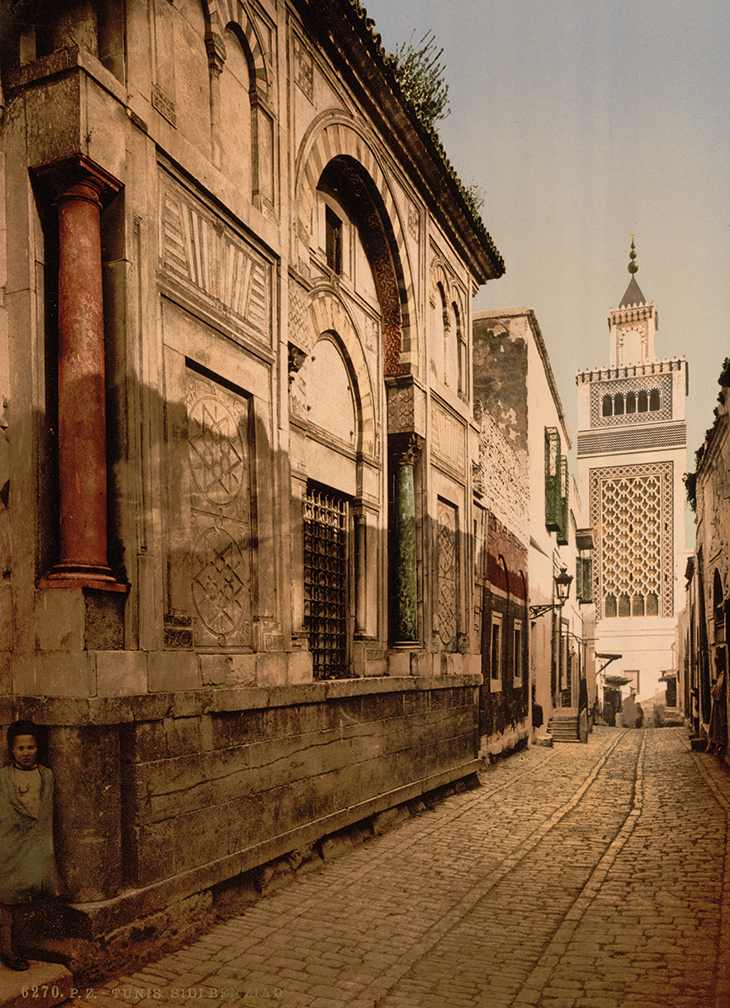
The centre of power gradually shifted from Tunis to the Sahel, Bourguiba’s own region. While the beldiya were overrepresented in the first constitutive assembly after independence, by 1971 they had only two seats and, by the end of Bourguiba’s rule, Sahelians held 58 per cent of positions, says Salhi Sghaier. ‘They still held positions, though maybe not in the highest level of the Makhzen. At first [Bourguiba] wanted control over them, then he compromised with them,’ he adds.
In order to weaken the Tunisois-dominated religious elite as well, Bourguiba abolished the status of waqf (endowments of property for religious or charitable causes), resulting in the recovery of property and the creation of one of the biggest national collections of manuscripts in the Arab world: 23,000 titles and 40,000 manuscripts. But heritage conservation projects concentrated on the Carthaginian and Roman periods – a carry-over from French colonial heritage policy, which also allowed Bourguiba to emphasise Tunisia’s links with Europe. Today, only three or four out of 60 researchers focus on the modern period at the INP, says Moumni, who curated ‘The Awakening of a Nation: Art at the Dawn of Modern Tunisia’, a rare exhibition on the beylical era, at the Ksar Saïd Palace in 2016. ‘You don’t find museums on the Ottoman period in Tunisia, we put these objects in warehouses and a lot of them will disappear [i.e. get stolen] and disappear from the memories of everyone.’
Even the fabric of the medina itself is disappearing, says Meddeb. Marble columns, Andalusian-style stucco and intricately painted ceramic tiles are pulled off abandoned dwellings, replaced with wood when structurally necessary, and then sold to decorate houses in the chic suburbs of Gammarth, La Marsa and Sidi Bou Said, where many beldi descendants now live. They are among the main buyers, Meddeb says: ‘It is the nostalgics, the people who want to have historic things. A bit of authenticity in their house.’
From the October 2020 issue of Apollo. Preview and subscribe here.

